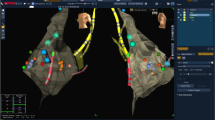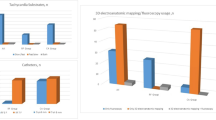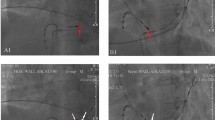Abstract
Purpose
The incidence of atrial flutter following radiofrequency ablation of supraventricular tachycardias is poorly understood. Ablation of atrioventricular nodal reentry tachycardia may place patients at risk of flutter because ablation of the slow pathway is in close proximity to the cavotricuspid isthmus. This study aims to evaluate the risk of atrial flutter following ablation of atrioventricular nodal reentry tachycardia relative to ablation of other supraventricular tachycardias.
Methods
A single-center retrospective analysis was completed for all supraventricular tachycardia ablations performed between July 2006 and July 2016. Patient and procedural details were collected for 544 patients who underwent atrioventricular nodal reentry tachycardia ablation (n = 342), atrioventricular reentry tachycardia ablation (n = 125), or atrial tachycardia ablation (n = 60). Follow-up for flutter after ablation of their incident arrhythmia was assessed.
Results
Patients who underwent atrioventricular nodal reentry tachycardia ablation were more likely to develop CTI-dependent flutter than patients who underwent ablation of other supraventricular tachycardias (4.97% vs. 0%; p = 0.002). Compared with patients who did not develop flutter, patients who developed flutter after atrioventricular nodal reentry tachycardia ablation were more likely to have undergone ablation of atypical atrioventricular nodal reentry tachycardia (11.8% vs. 2.15%; p = 0.016).
Conclusions
We identified an association between atrioventricular nodal reentry tachycardia ablation and development of CTI-dependent atrial flutter. This finding may have implications for the management and follow-up after atrioventricular nodal reentry tachycardia ablation.


Similar content being viewed by others
Abbreviations
- AF:
-
Atrial fibrillation
- AFL:
-
Atrial flutter
- AT:
-
Atrial tachycardia
- AVNRT:
-
Atrioventricular nodal reentry tachycardia
- AVRT:
-
Atrioventricular reentry tachycardia
- CHF:
-
Congestive heart failure
- CTI:
-
Cavotricuspid isthmus
- RF:
-
Radiofrequency
- SP:
-
Slow pathway
- SVT:
-
Supraventricular tachycardia
References
Granada J, Uribe W, Chyou PH, Maassen K, Vierkant R, Smith PN, et al. Incidence and predictors of atrial flutter in the general population. JACC. 2000;36(7):2242–6.
Garson A Jr, Bink-Boelkens M, Hesslein PS, Hordof AJ, Keane JF, Neches WH, et al. Atrial flutter in the young: a collaborative study of 380 cases. JACC. 1985;6:871–8.
Cosio FG. Atrial flutter, typical and atypical: a review. Arrhythm and Electrophysiol Rev. 2017;6(2):55–62.
Waldo AL. Pathogenesis of atrial flutter. J Cardiovasc Electrophysiol. 1998;9(8 Suppl):S18-25.
Kalbfleisch SJ, El-Atassi R, Calkins H, Langberg JJ, Morady F. Association between atrioventricular node reentrant tachycardia and inducible atrial flutter. JACC. 1993;22:80–4.
Interian A, Cox MM, Jimenez RA, Duran A, Levin E, Garcia O, et al. A shared pathway in atrioventricular nodal reentrant tachycardia and atrial flutter: implications for pathophysiology and therapy. J Am Coll Cardiol. 1993;71(4):297–303.
Kimman GP, Van Hemel NM, Jessurun ER, van Dessel PF, Kelder JC, Defauw JJ, et al. Comparison of late results of surgical or radiofrequency catheter modification of the atrioventricular node for atrioventricular nodal reentrant tachycardia. Eur Heart J. 1999;20:480–1.
Kimman GP, Bogaard MD, Van Hemel NM, van Dessel PF, Jessurun ER, Boersma LV, et al. Ten year follow-up after radiofrequency catheter ablation for atrioventricular nodal reentrant tachycardia in the early days forever cured, or a source for new arrhythmias? Pacing Clin Electrophysiol. 2005;28:1302–9.
Takagi Y, Watanabe I, Okumura Y, Okubo K, Ashino S, Kofune M, et al. Inducibility of atrial flutter in patients with atrioventricular nodal reentrant tachycardia. Circ J. 2006;70(9):1133–7.
Lin CH, Lin YJ, Chang SL, Lo LW, Huang HK, Chiang CH, et al. Novel electrophysiological characteristics of atrioventricular nodal continuous conduction curves in atrioventricular nodal re-entrant tachycardia with concomitant cavotricuspid isthmus-dependent atrial flutter. Europace. 2016;18:1259–64.
Schernthaner C, Danmayr F, Strohmer B. Coexistence of atrioventricular nodal reentrant tachycardia with other forms of arrhythmias. Med Princ Pract. 2014;23(6):543–50.
Brachmann J, Lewalter T, Kuck KH, Andresen D, Willems S, Spitzer SG, et al. Long-term symptom improvement and patient satisfaction following catheter ablation of supraventricular tachycardia: insights from the German ablation registry. Eur Heart J. 2017;38(17):1317–26.
Author information
Authors and Affiliations
Corresponding author
Ethics declarations
Conflict of interest
W.H.S. receives significant research grants from Biosense Webster and educational grants from St. Jude Medical, Boston Scientific, Biosense Webster, and Medtronic. No grants or external funding were used to help conduct this study. The authors declare no conflict of interest that would influence the preparation of this manuscript.
Additional information
Publisher's note
Springer Nature remains neutral with regard to jurisdictional claims in published maps and institutional affiliations.
Supplementary Information
Below is the link to the electronic supplementary material.
Rights and permissions
About this article
Cite this article
Varela, D.L., Rosenberg, M.A., Borne, R.T. et al. Increased incidence of cavotricuspid isthmus atrial flutter following slow pathway ablation. J Interv Card Electrophysiol 63, 581–589 (2022). https://doi.org/10.1007/s10840-021-01065-0
Received:
Accepted:
Published:
Issue Date:
DOI: https://doi.org/10.1007/s10840-021-01065-0




